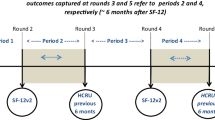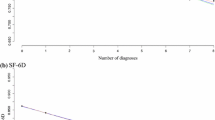Abstract
Purpose
Documenting the impact of different types of cancer on daily functioning and well-being is important for understanding burden relative to other chronic medical conditions. This study examined the impact of 10 different cancers and 13 other chronic medical conditions on health-related quality of life.
Methods
Health-related quality of life data were gathered on the Medicare Health Outcomes Survey (MHOS) between 1998 and 2002. Cancer information was ascertained using the National Cancer Institute’s surveillance, epidemiology, and end results program and linked to MHOS data.
Results
The average SF-6D score was 0.73 (SD = 0.14). Depressive symptoms had the largest unique association with the SF-6D, followed by arthritis of the hip, chronic obstructive pulmonary disease/asthma, stroke, and sciatica. In addition, the majority of cancer types were significantly associated with the SF-6D score, with significant negative weights ranging from −0.01 to −0.02 on the 0–1 health utility scale. Distant stage of cancer was associated with large decrements in the SF-6D ranging from −0.04 (prostate) to −0.08 (female breast).
Conclusion
A large number of chronic conditions, including cancer, are associated uniquely with decrements in health utility. The cumulative effects of comorbid conditions have substantial impact on daily functioning and well-being of Medicare beneficiaries.
Similar content being viewed by others
References
Rothrock, N. E., Hays, R. D., Spritzer, K., et al. (2010). Relative to the general US population chronic diseases are associated with poorer health-related quality of life as measured by the patient-reported outcomes measurement information system (PROMIS). Journal of Clinical Epidemiology, 63, 1195–1204.
Altekruse SF, Kosary CL, Krapcho M, et al (eds) SEER Cancer Statistics Review 1975–2007 National Cancer Institute: Bethesda MD. Available from URL: http://seer.cancer.gov/csr/1975_2007 Accessed 27 Aug 2012.
Smith, A. W., Reeve, B. B., Bellizzi, K. M., et al. (2008). Cancer comorbidities and health-related quality of life of older adults. Health Care Financing Review, 29, 41–56.
Brazier, J., Roberts, J., & Deverill, M. (2002). The estimation of a preference-based measure of health from the SF-36. Journal of health economics, 21, 271–292.
Brazier, J., & Roberts, J. (2004). The estimation of a preference-based measure of health from the SF-12. Medical Care, 42, 851–859.
Ambs, A., Warren, J. L., Bellizzi, K. M., et al. (2008). Overview of the SEER-medical health outcomes survey (MHOS) linked dataset. Health Care Financing Review, 29, 5–22.
Ries LAG, Melbert D, Krapcho M, et al (eds.) SEER Cancer Statistics Review 1975–2004 Available from URL: http://seer.cancer.gov/csr/1975_2004/ Based on November 2006 SEER data submission. Accessed 27 Aug 2012.
Clauser, S. B., Arora, N. K., Bellizzi, K. M., et al. (2008). Disparities in HRQOL of cancer survivors and non-cancer managed care enrollees. Health Care Financing Review, 29, 23–40.
Ware, J. E., & Sherbourne, C. D. (1992). The MOS 36-item short-form health survey (SF-36): Conceptual framework and item selection. Medical Care, 30, 473–483.
Brazier, J., Rowen, D., & Hanmer, J. (2008). Revised SF-6D scoring programmes: a summary of improvements. Patient Reported Outcomes Newsletter, 48, 16–17. Fall.
Lumley, T., Diehr, P., Emerson, S., & Chen, L. (2002). The importance of the normality assumption in large public health data sets. Annual Review Publish Health, 23, 151–169.
Williams, R. L. (2000). A note on robust variance estimation for cluster-correlated data. Biometrics, 56, 645–646.
Basu, A., & Rathouz, P. J. (2005). Estimating marginal and incremental effects on health outcomes using flexible link and variance function models. Biostatistics, 6, 93–109.
Hanmer, J. (2009). Predicting an SF-6D preference-based score using MCS and PCS scores from the SF-12 or SF-36. Value Health, 12, 958–966.
Hays, R. D., Kim, S., Spritzer, K. L., et al. (2009). Effects of mode and order of administration on generic health-related quality of life scores. Value Health, 12, 1035–1039.
Ware JE, Kosinski M, Keller SD. (1994). SF-36 physical and mental health summary scales: A user’s manual boston massachusetts: New England medical center.
Sullivan, P. W., Lawrence, W. F., & Ghushchyan, V. (2005). A national study of preference-based scores for chronic conditions in the United States. Medical Care, 43, 736–749.
Walters, S. J., & Brazier, J. E. (2003). What is the relationship between the minimally important difference and health state utility values? The case of the SF-6D. Health Quality Life Outcomes, 11, 1–4.
Khanna, D., Furst, D. E., Wong, W. K., et al. (2007). Reliability validity and minimally important differences of the SF-6D in systemic sclerosis. Quality of Life Research, 16, 1083–1092.
Miller, D. R., Rogers, W. H., Kazis, L. E., et al. (2008). Patients’ self-report of diseases in the medicare health outcomes Survey based on comparisons of linked survey and medical data from the veterans administration. The Journal of ambulatory care management, 31, 161–177.
Garau, M., Shah, K., Mason, A. R., et al. (2011). Using QALYs in cancer: A review of the methodological limitations. Pharmacoeconomics, 29, 673–685.
Feeny, D., Spritzer, K., Hays, R. D., et al. (2011). Agreement about identifying patients who change over time: Cautionary results in cataract and heart failure patients. Medical Decision Making, 32, 273–286.
Acknowledgements
This project was supported by NCI internal funds. Dr. Hays was also supported in part by grants from NIA (P30AG021684) and the NIMHD (2P20MD000182). The SEER-MHOS linked data set is now in the public domain. More information about the data set is available at http://outcomes.cancer.gov/surveys/seer-mhos/. For questions, technical support is available at SEER-MHOS@azqio.sdps.org.
Author information
Authors and Affiliations
Corresponding author
Rights and permissions
About this article
Cite this article
Hays, R.D., Reeve, B.B., Smith, A.W. et al. Associations of cancer and other chronic medical conditions with SF-6D preference-based scores in Medicare beneficiaries. Qual Life Res 23, 385–391 (2014). https://doi.org/10.1007/s11136-013-0503-9
Accepted:
Published:
Issue Date:
DOI: https://doi.org/10.1007/s11136-013-0503-9




